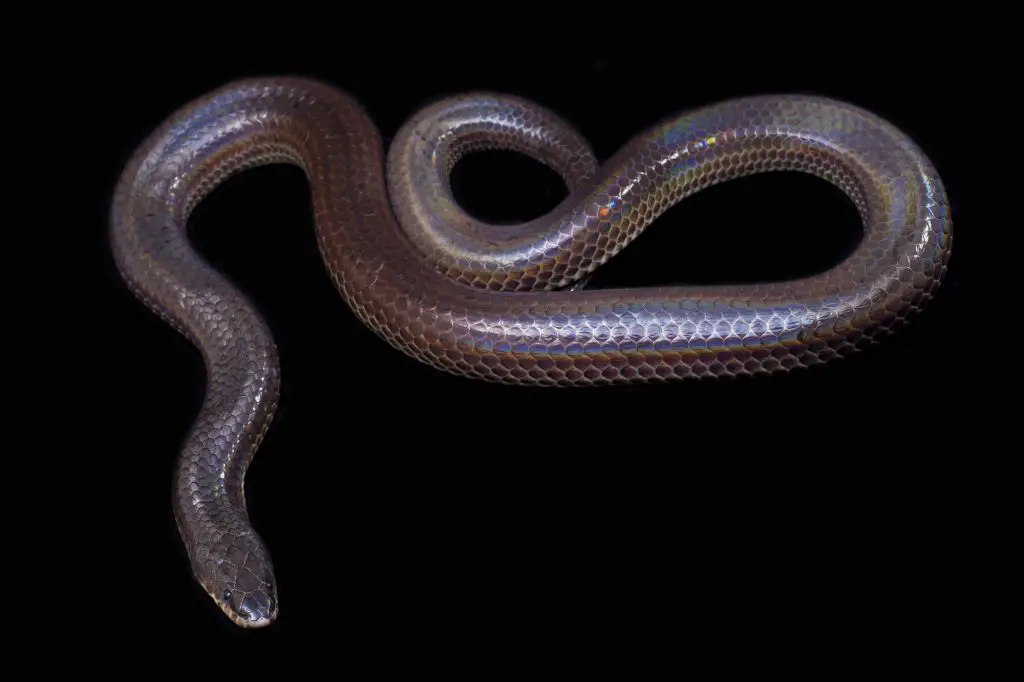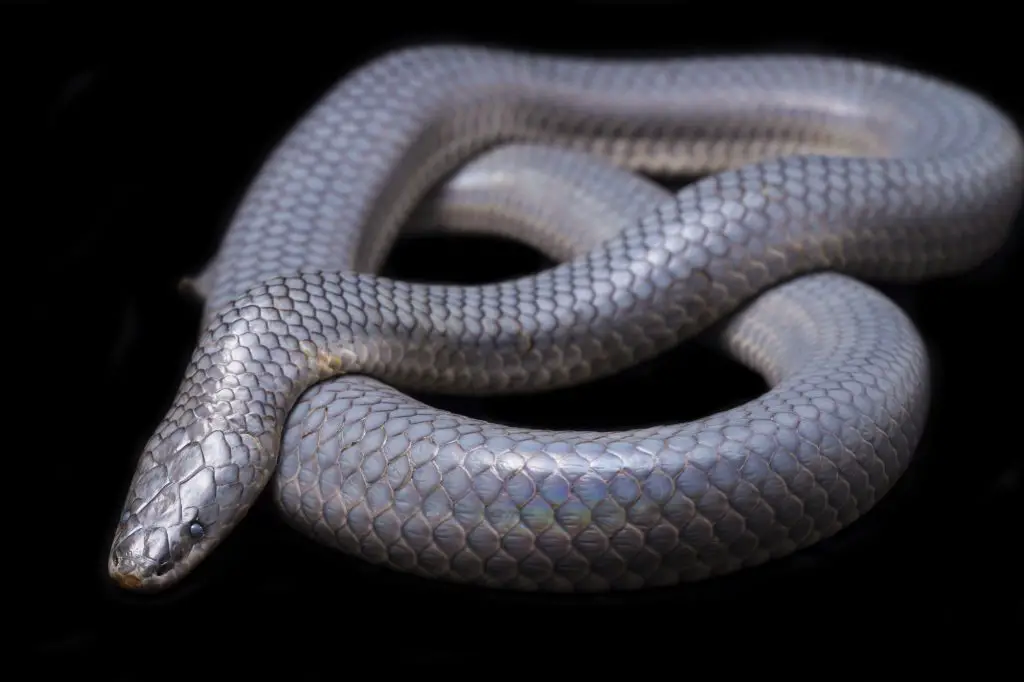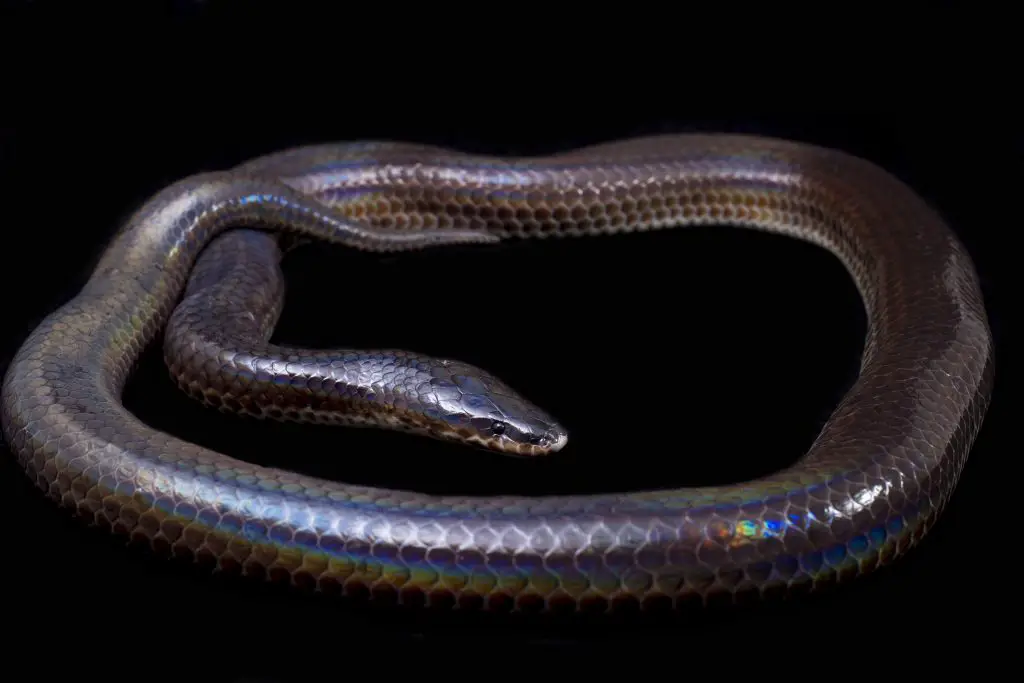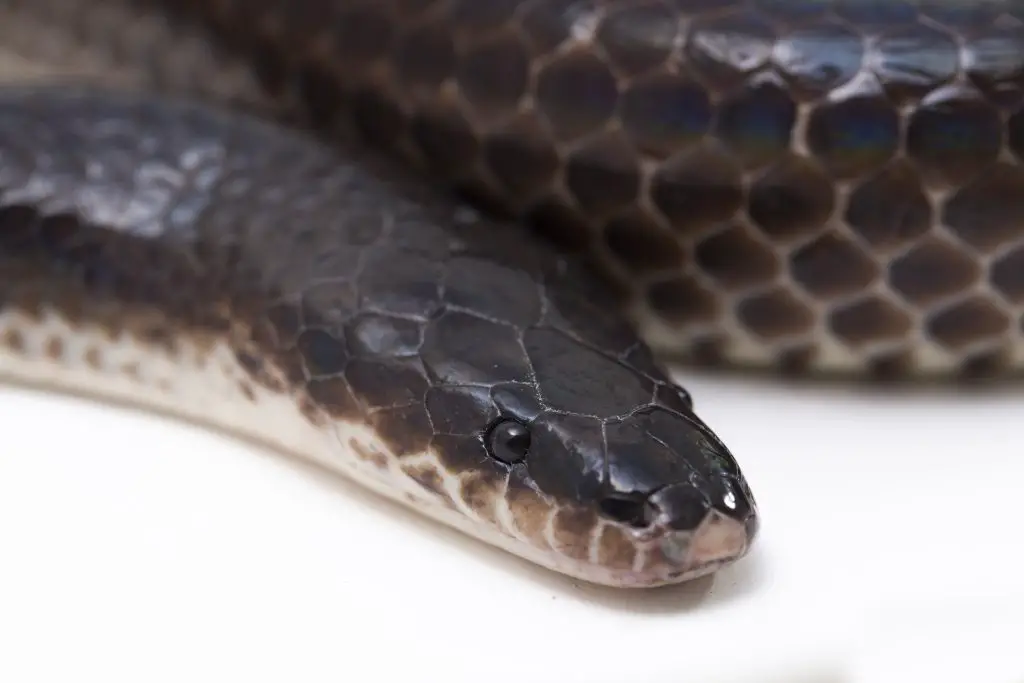Sunbeam Snake Care is tough if you try to keep a wild-caught animal. That said, they are great if you can find a healthy captive-bred one…
Last updated on February 1st, 2023 at 09:24 am
Sunbeam Snakes are beautiful animals whose dorsal scales produce a mesmerizing iridescence which makes them unique. They like to live underground and come out to hunt at night. If you want to keep one of these snakes, be aware that they are hard to care for and sensitive with regards to humidity and heat.
In truth, your best chance of keeping a Sunbeam Snake alive is if you buy a healthy, captive-bred animal. In that scenario, this care sheet will tell you how get its enclosure, substrate, temperature, diet, and humidity right.
Description And Size
The Sunbeam snake grows to about 3 or 4 feet in its lifetime of 15 to 20 years. The sunbeam is a dark colored snake with a light colored underbelly.
The dorsal scales are deep brown to black. The ventral scales are cream colored or white.
Its body is thicker compared to its small narrow neck. It has a triangular protracted head with very small black eyes.
But its main feature which helps to identify it is the iridescence of the dorsal scales. This is what sets it apart from all the monochromatic snakes that look similar to it. All-in-all, the only snakes that come anywhere close in irredescence are the Brazilian Rainbow Boa and White Lipped Pythons.
When the sunlight shines on its scales they give off the most brilliant bright rainbow color. This is probably helpful for confusing predators in the wild (just a theory of mine!).
Classification
You may notice that Sunbeam Snakes are stocky, and kind of python-like in build. This is because, as far as we know, these primitive snakes probably are most closely related to pythons.
As you can see from the phylogeny table below, Sunbeam Snakes have only two species, placed in the Xenopeltidae family. The Xenopeltidae is monotypic family – meaning it contains only one genus.
In that genus are only two recognised species, Xenopeltis unicolor and Xenopeltis hainanensis. All this to tell you that Sunbeam Snakes are extremely unique, and have no close relatives.
| Order: | Squamata |
| Suborder: | Serpentes |
| Family: | Xenopeltidae |
| Genus: | Xenopeltis |
| Species: | Xenopeltis unicolor and Xenopeltis hainanensis |

Sunbeam Snake Habitat
The Sunbeam snake originates from parts of South East Asia, to Indonesia, the Philippines and Southeastern China. It is highly endemic and only appears in the wild in small isolated pockets.
It is a nocturnal hunter and feeds on local small game like birds, reptiles, amphibians, smaller snakes and a few mammals. They have a tendency to remain hidden during the day.
They burrow into the soft moist earth in shallow burrows in the mud and decaying vegetation. They are commonly found in rice paddies, marshes, ditches, and damp forests.
Sunbeam Snake Enclosure
Since the Sunbeam snake prefers to spend time in burrows, they do not need elaborate tanks. But the soil must be soft enough for the burrowing behavior.
The soil should be deep enough and enriched with rocks and pieces of bark. Makeshift tunnels can made of PVC are good.
The snakes also require a large water dish to slither through as they prefer moisture. But excess buildup of condensation is harmful for them.
With excess water build up in the enclosure and the presence of rich organic matter bacteria grow to harmful levels. They stay well in both plastic tubs or glass tanks.

Sunbeam Snake Tank Size
Sunbeam tank size varies with the individual snake. Older snakes require larger enclosures as they keep growing during their entire lifetime.
The recommended sizes required for plastic tubs are as follows:
- The juvenile snakes (below 18 inch) require 15 quart plastic tubs.
- The subadult snakes (between 18 inch and 30 inch) require 32 quart plastic tubs.
- The adult snakes (from 30 inch to over 48 inch) require 106 quart plastic tubs or a 34 inch x 18 inch x 9 inch PVC enclosure.
The recommended sizes required for glass tanks are as follows:
- The juvenile snakes (below 18 inch) require a 10 gallon (20 inch x 10 inch x 12 inch) long tank.
- The subadult snakes (between 18 inch and 30 inch) require a 15 gallon (24 inch x 12.5 inch x 13 inch) long tank.
- The adult snakes (from 30 inch to over 48 inch) require a 20 gallon (30 inch x 12 inch x 12 inch) long tank.
Substrate
The most important thing to keep in mind when you own a Sunbeam Snake is that they are burrowers. So the substrate is must allow the snake to burrow with ease.
The substrate should be deep enough, at least 4 to 5 inches. It should be able to hold moisture but not retain too much water.
The soil used can be regular potting soil or coconut coir but it has should have cypress mulch, moss and loose reptile bark. You can add vermiculture compost to maintain a constant level of moisture.
A drainage layer and periodic misting help to ensure an even distribution of moisture. A slight slant may also help to ensure that the moisture level is high at one end and low at the other.
This ensures that the Sunbeam Snake can choose the area it wants to inhabit at any given time based on which is more suited to its needs.

Temperature
Sunbeams are tropical snakes which are naturally used to warm temperatures. So they typically need a nice, tropical kind of heat to thrive.
But the temperature in the enclosure should be slightly variable to provide the snake with ideal heating conditions at all times. You should not use overhead bulbs or heaters as it will dry out the substrate.
The hottest part of the enclosure should be between 82 to 85℉ and the coolest part of the enclosure should be between 70 to 75℉.
For warmth, under tank heaters with radiant heat panels work best. All heating elements should have thermostats attached with them to help in regulating ideal temperature.
UV light is not necessary as the Sunbeam spends most of its time underground.
Diet
Sunbeams are hunters in nature and can eat smaller animals by lunging at them and quickly strangling them. They swallow their kill whole.
In captivity it is harder to provide them with the variety of insects, reptiles, amphibians, birds and mammals they naturally feed on. This is because the easiest foods to find for sale are frozen rodents.
It is easy to maintain a steady flow of this diet. Also, rodents are nutritionally complete if sourced from a reputable supplier.
But you might have to train the Sunbeam to feed on these as they hunt on live prey in the wild. In such cases you have to start with live prey mice and gradually shift to the frozen and thawed mice. This is the kind of measure that I personally don’t like, but with imported animals in particular it is sometimes the only way.
As with most snakes, the food items should only be as wide as the widest part of the snake’s body. Overfeeding causes obesity and fatty liver disease.
Water And Humidity
Sunbeam Snakes originate from tropical areas and tend to burrow in damp places. So maintain humidity at a high level for them to survive and be healthy.
The moisture content of the air should be between 80% to 100%. Add a humidifier and artificial airflow maintained if you live an a place where the weather is dry.
The most important aspect of maintaining the right moisture content is to maintain the moisture in the soil. For this the right soil with proper drainage has to be created.
One end of the soil may be raised to ensure a dry end and a wet end is created and the snake can use the gradient. But the moisture content in all areas of the soil must be above 75% at all times.
But the soil should not be flooded. Also, heating elements which may dry out the soil should not be used.
The soil should be lightly misted once a week for a few minutes at a time.

Temperament
Sunbeams are naturally secretive and appear above the surface only to hunt. So they enjoy their privacy and get stressed when they are handled too much.
But they are soft and smooth to the touch and are not aggressive. Occasionally getting them out of the tank and petting them is fine.
They are not known for ever attacking humans. So they are very safe as pets even in houses with small children.
They do not climb even if branches are provided. As long as they are provided with a solitary life in their tanks and not disturbed too much, they make for delightful pets.
Sunbeam Snake Lifespan
Sunbeam snakes are relatively hardy when established and can tolerate captive life well if stable conditions are provided. They can be treated for common health issues with appropriate and timely medical intervention.
So they can survive for very long times in captivity. They typically live for fifteen years of age.
With good living conditions, regular care and a healthy diet they can live for as long as twenty years. This is because they are difficult to rear in captive conditions.
So all Sunbeam snakes are captured from the wild and have a strong genetic make up with almost no congenital defects.
Captive Bred Sunbeam Snake For Sale
There are very few Sunbeam Snakes for sale which are captive bred. This is because they are not well established in captivity.
Most Sunbeams are wild captive snakes imported from parts of China. As a result they arrive in poor condition with skin blisters and worms.
Such animals require intense veterinarian care before they can be settled into housing tanks. Backwater Reptiles sell them and ensure that all arrivals are healthy.
If you’re looking for a pet Sunbeam Snake then your best bet really is a captive-bred animal. At the very least, look for a healthy, long-term captive that is feeding well.
Though hard to find, captive-bred Sunbeam Snakes are sometimes seen for sale on sites like Morphmarket.com for as little as $150-250 (£125-200).

FAQ Relating To Sunbeam Snake Care
Do Sunbeam Snakes make good pets?
Sunbeam Snakes make good pets if they are well established and captive-bred. You also need to be happy with a pet that you rarely see. Wild-caught Sunbeam Snakes, on the other hand, make terrible pets. They often arrive in ill health and die within months.
Are sunbeam snakes hard to keep?
Well established Sunbeam Snakes are not hard to keep. They are delicate though. You need to get their humidity right, and maintain it perfectly for them to do well.
Do Sunbeam Snakes Like To Be Held?
No, Sunbeams are naturally solitary predators and they do not like to be held. But they are good at tolerating handling and will not attack if they are held rarely.
Do Sunbeam Snakes Musk?
Sunbeam snakes have a defense mechanism of secreting a smelly musk to avoid predators. This snake secretes the same musk when they are stressed due to too much handling in captivity.

